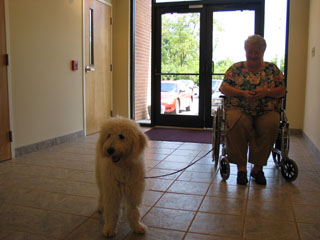Labradoodles As Therapy Dogs
Introduction
Animal assisted therapy has become an important tool in many types of therapy. Originally used in hospitals and nursing homes, its use has grown into other venues as the therapeutic advantages are realized. Studies show animal assisted therapy applications to be vast, limited only by imagination and resources.
Over the years, I have collected a large amount of research and information and would like to make this available for anyone with the interest. I started collecting research on the human-animal bond and dog assisted therapy originally when I working as an outpatient clinician for a non profit agency. I was in the process of having my now 9 year old Labrador Retriever, Nyala, certified as a therapy dog. I knew my dogs were good therapy, now I just had to convince the boss! He thought I just wanted to bring my dogs to work, which, of course, had an element of truth. They are always good therapy for me and I wanted to demonstrate they were good therapy for others as well. Over the years, I have seen this demonstrated many times.
Do Labradoodles make good therapy dogs? I believe the characteristics that make the Australian Labradoodle a good companion also make them excellent candidates for therapy dogs. To become a therapy dog, you must assess your Labradoodles particular temperament, social and emotional skills and needs, and provide training based on that assessment. The information below will help you understand what is required and the commitment you will need to make.
The Animal - Human Connection
In my practice, I have found that physical contact with an animal can be very healing. People who are physically or emotionally isolated from others due to their inability to trust or bond can begin the healing process through their connection with a therapy dog. Animal assisted therapy allows counselors to breach the psychological wall people often bring to therapy. Innovative techniques such as art, music, and play therapy have long been used to assist people in overcoming psychological blocks and emotional distress. Likewise, animal assisted therapy can reduce feelings of isolation and provide a feeling of safety and unconditional acceptance.
Therapy Dog Qualities
Not all dogs make good therapy dogs and not all dogs are appropriate for all therapy dog activities. For example, some dogs do not make good visitors at hospitals due to slick floors and noise levels. However, they may make wonderful visitors for shut-ins. A vital first step is determining your dog's personality. Determining your dogs personality will help you identify the types of therapy activities your dog is best suited for and the type of training you will need to do. A good veterinarian, breeder, or trainer will be able to help you assess your dog's personality and determine what activities would be best for your dog. Below are the most important considerations in determining your puppy's suitability as a therapy dog.
Assessing Your Labradoodle Puppy's Personality
Has the puppy had lot's of healthy human interaction?
Puppies require a lot of healthy human contact to prevent them from being afraid of people, especially between the third and sixteenth weeks of life. A reputable breeder will have extensive hands on contact with your puppy during this stage of life. When you obtain your puppy at around 8 weeks of age, you may want to ensure that the puppy has human contact with a variety of people. Remember that it is not safe for your puppy to have contact with dogs or dog feces during this time, but familiarity with a variety of humans is safe and important.
Does your puppy seek human contact or withdraw?
When evaluating a puppy, pay attention to if they seek human contact or withdraw. Puppies that withdraw, may need a calmer approach to training. Remember, each puppy has individual needs. A reputable breeder can help match you with a desirable pup and a good trainer may help you train your puppy taking in their individual needs.
How does your puppy respond when you hold her on her back for a few minutes?
A very dominate puppy will struggle to regain control, a timid puppy will show signs of fear, and a beta puppy will be somewhat relaxed (as relaxed as most puppies ever are!). Most pups are different at different times. Pay attention to the trend. A dominate puppy means you will spend more time obtaining their attention. A fearful pup needs to be exposed gently to new situations and require extra attention to boost their confidence. You are hopefully working toward a balanced pup that will be confident and poised in a variety of situations.
How does your puppy respond to being groomed?
All therapy dogs must be well groomed prior to any visit. I brush my dogs teeth daily, do their nails weekly and clean and brush their coat prior to any visit. A good rule of thumb is to have your puppy become used to being groomed early in life. This allows for human contact and a dog who cooperates with the process of being groomed.
Assessing Your Labradoodle's Suitability For Therapy Dog Activities
How does your dog respond to unusual situations?
Dogs who visit nursing homes and hospitals are required to be around many unusual sounds, sights, and experiences. They must be comfortable with wheel chairs, loud noise, people going by, food at their eye level which they may not touch, elevators, slick floors, and the list goes on. Difficulty in dealing with some situations does not mean a dog cannot be a therapy dog. My beautiful Labrador, Nyala, is a certified therapy dog, but cannot tolerate elevators. She falls to the floor and starts shaking. So, I walk the stairs when she is with me. Concessions can be made, but the dog must be able to tolerate a great deal of stimuli and maintain focus and discipline. Most puppies are unable to curb their enthusiasm and natural curiosity to be calm during the above experiences. However, when your dog is a puppy it is very good time to introduce them to lots of situations in controlled and measured amounts, such as brief visits to a nursing home or other facility. This will help ensure a great temperament and confidence as an adult, whether you plan to use your puppy in a therapy program or not.
Is your dog friendly?
How does your dog act when seeing another person on a walk? Are they able to greet without jumping? Are they able to accept being ignored when a person is too busy to pay attention to them? Does your dog enjoy being petted by strangers? How do they react around other dogs? Cats and other animals? (Animal Assisted therapy often includes other species.) If your dog is not perfect, don't worry, some of this is experience and training. If your dog is hyper, you may need to work with them in other activities prior to adding therapy visits to their resume. Many people tell me their dog is hyper, when in fact it is under stimulated and under exercised. All dogs are hyper if they are bored and are not exercised. If your dog is aggressive, it will need intensive training and this is probably not the activity best suited for your dog. Some dogs are fear based in nature and need less stimulation than this sort of interaction.
Is your dog well-trained?
Basic obedience is a must. Training includes making eye contact with your dog so that you easily have their attention in any situation. You need to be able to keep your dog from pulling you or another person, should you turn the leash over to them. Basic obedience helps you to teach your puppy to respond on the first command, how to interact with positive rewards, and how to have your puppy give you their attention when needed.
Therapy Dog Training and Certification
So, you've determined your dog will make a good therapy dog, what's next? First, you must make a commitment to training. Certification is performed by Therapy Dogs International. A dog must be at least 1 year old before they may be tested, so expect to spend the better part of a year in training and exposing your dog to lots of different situations. Therapy Dogs International will provide you with certification requirements and provide you with the information needed to develop a training plan. Click here for more links on how to get started and other information on therapy dogs.



